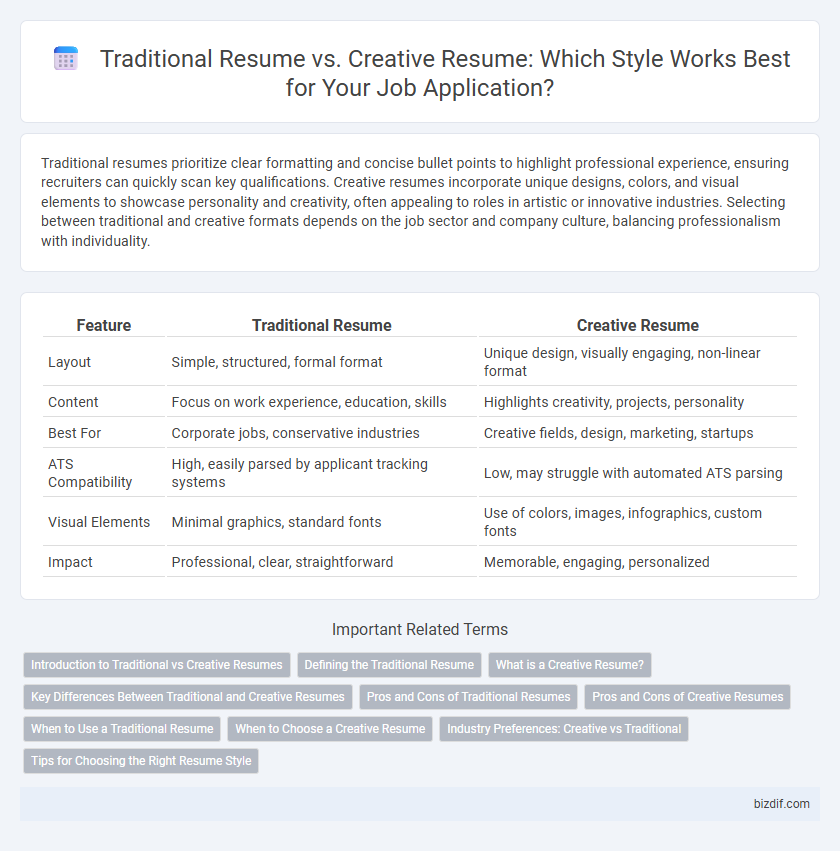Traditional resumes prioritize clear formatting and concise bullet points to highlight professional experience, ensuring recruiters can quickly scan key qualifications. Creative resumes incorporate unique designs, colors, and visual elements to showcase personality and creativity, often appealing to roles in artistic or innovative industries. Selecting between traditional and creative formats depends on the job sector and company culture, balancing professionalism with individuality.
Table of Comparison
| Feature | Traditional Resume | Creative Resume |
|---|---|---|
| Layout | Simple, structured, formal format | Unique design, visually engaging, non-linear format |
| Content | Focus on work experience, education, skills | Highlights creativity, projects, personality |
| Best For | Corporate jobs, conservative industries | Creative fields, design, marketing, startups |
| ATS Compatibility | High, easily parsed by applicant tracking systems | Low, may struggle with automated ATS parsing |
| Visual Elements | Minimal graphics, standard fonts | Use of colors, images, infographics, custom fonts |
| Impact | Professional, clear, straightforward | Memorable, engaging, personalized |
Introduction to Traditional vs Creative Resumes
Traditional resumes emphasize a clean, straightforward format highlighting work experience, skills, and education in a chronological or functional layout favored by conservative industries. Creative resumes incorporate design elements, infographics, and unique layouts to showcase personality and innovation, appealing to roles in marketing, design, and media. Understanding the distinction helps tailor resume strategies to industry expectations and job requirements.
Defining the Traditional Resume
The traditional resume follows a clear, structured format emphasizing chronological work experience, education, and skills, making it easy for recruiters to scan quickly. It uses standard fonts, bullet points, and formal language to present professional qualifications succinctly. This classic approach suits conservative industries like finance, law, and healthcare, where clarity and professionalism are paramount.
What is a Creative Resume?
A creative resume uses innovative design elements, visuals, and unique layouts to showcase skills and personality, making it ideal for industries like marketing, design, and media. Unlike traditional resumes, which emphasize a straightforward, text-based format, creative resumes highlight creativity and individuality to capture employers' attention quickly. Incorporating infographics, colors, and custom fonts, creative resumes enhance visual appeal while maintaining clarity and professionalism.
Key Differences Between Traditional and Creative Resumes
Traditional resumes emphasize clear, concise formatting with a focus on chronological work history, professional skills, and standard fonts to appeal to conservative industries. Creative resumes incorporate visually engaging elements such as graphics, colors, unique layouts, and multimedia to showcase personality and creativity, often favored in design, marketing, and arts sectors. Key differences lie in presentation style, level of customization, and target industry preference, impacting how hiring managers perceive professionalism and innovation.
Pros and Cons of Traditional Resumes
Traditional resumes offer a clear, structured format that is widely accepted by hiring managers and applicant tracking systems, ensuring higher compatibility with automated screening tools. They emphasize professionalism and concise presentation of skills, work experience, and education without distracting visuals that could overpower content. However, traditional resumes may lack uniqueness and fail to stand out in creative industries where innovative design and personalized branding are valued.
Pros and Cons of Creative Resumes
Creative resumes showcase unique design elements and personalized layouts that capture recruiter attention and demonstrate individuality. These formats can highlight skills visually, making them ideal for industries like marketing or design, but may be rejected by Applicant Tracking Systems (ATS) due to non-standard formatting. Creative resumes risk overshadowing content with style and can confuse recruiters accustomed to traditional structures, potentially limiting opportunities in conservative fields.
When to Use a Traditional Resume
A traditional resume is ideal for industries such as finance, law, and healthcare where adherence to formal formats is expected and professionalism is paramount. It effectively highlights structured work experience, certifications, and clear career progression, which recruiters in conservative fields prefer. Using a traditional resume increases the likelihood of passing Applicant Tracking Systems (ATS) that prioritize keyword-rich, straightforward layouts.
When to Choose a Creative Resume
A creative resume is ideal for professionals in design, marketing, or media industries where visual impact and originality demonstrate relevant skills. Choosing a creative resume helps candidates stand out in competitive fields by showcasing personality and innovative thinking through unique layouts and graphics. Traditional resumes remain preferable for conservative sectors like finance or law, where clarity and formality are prioritized over design elements.
Industry Preferences: Creative vs Traditional
Traditional resumes remain the preferred format in conservative industries such as finance, law, and government due to their clear structure and straightforward presentation of qualifications. Creative resumes, featuring unique designs and infographics, appeal mainly to marketing, design, and tech sectors that value innovation and individuality. Understanding specific industry preferences is crucial for tailoring a resume that aligns with employer expectations and increases the chances of landing an interview.
Tips for Choosing the Right Resume Style
Selecting the appropriate resume style depends on the industry and job role; traditional resumes suit conservative fields like finance or law, highlighting clear structure and detailed work history. Creative resumes, ideal for advertising, design, or media positions, emphasize visual elements and originality to showcase personality and innovative skills. Tailoring the resume format to align with employer expectations and job requirements enhances the chances of making a strong impression.
Traditional Resume vs Creative Resume Infographic

 bizdif.com
bizdif.com